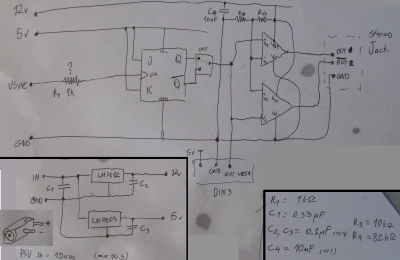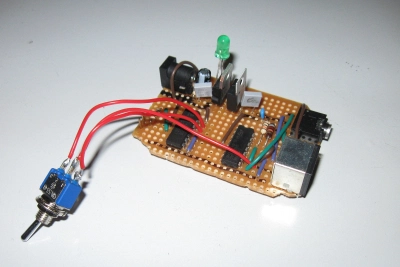

John Tsiombikas nuclear@mutantstargoat.com
2 March 2012
All my previous stereoscopic attempts are fun and cool, but what I really wanted was to manage to connect my cheap-o shutter glasses to my computer, and use them for stereoscopic rendering. The main barrier is that consumer nvidia cards do not include a stereo port (unlike expensive quadros), and their drivers don't support stereoscopic OpenGL visuals.
I had already side-stepped the second problem by writing
stereowrap, an LD_PRELOAD-based tool
that fakes OpenGL stereo contexts for GLX apps and presents the stereo pair in
a number of ways, such as various anaglyphs, side-by-side, etc.
So at some point I decided to attack the first problem. Turns out there's a simple way to drive shutter glasses. It's a brilliant idea, and I didn’t come up with it, but it boils down to making a simple circuit that toggles the shutter glasses when it detects a pulse on the montior vsync wire!
I immediately designed a circuit based on this design, but modified to work with the signals expected by my ASUS VR-100 shutter glasses. Then I wired it up on a perfboard, and it worked like a charm! Finally I added a sequential stereo presentation method to stereowrap, synchronized with vsync, and suddenly I can view all my stereoscopic programs in awesome full-color stereo glory.
The downside to this simple contraption is that it doesn't really know whether the left or the right image is presented at any given time, it only knows when to switch between them. That's why the switch is included in the circuit: if the image appears wrong, and you can really tell by your brain attempting to blow up while looking at it, the switch can be used to flip the glasses around instantly. If however the application can't catch up with the refresh rate of the monitor and misses a vsync interval the images will flip again.
I plan to build a more intelligent, microcontroller-based, driver circuit at some point. But for now, the simple vsync driver works well enough.
This was initially posted in my old wordpress blog. Visit the original version to see any comments.